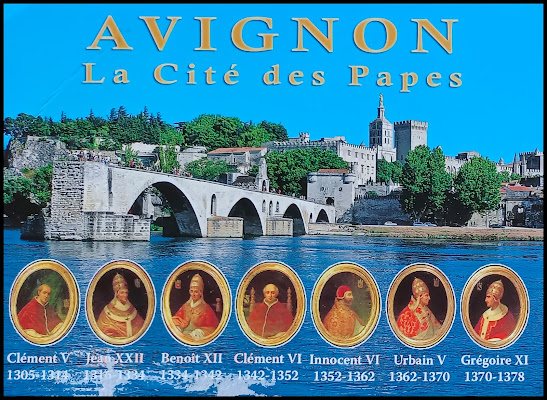Postcard sent to myself during a trip to France
Sent- 08 of July of 2019.
INSCRIPTION/INSCRITO: 1983
In the 14th century, this city in the South of France was the seat of the papacy. The Palais des Papes, an austere-looking fortress lavishly decorated by Simone Martini and Matteo Giovanetti, dominates the city, the surrounding ramparts and the remains of a 12th-century bridge over the Rhone. Beneath this outstanding example of Gothic architecture, the Petit Palais and the Romanesque Cathedral of Notre-Dame-des-Doms complete an exceptional group of monuments that testify to the leading role played by Avignon in 14th-century Christian Europe.
Located on the banks on the Rhône River in the Provence-Alpes-Côte-d’Azur region, Avignon is known as the City of the Popes. Its historic centre, comprising the the Papal Palace, the Episcopal ensemble and the Avignon Bridge, is an outstanding example of medieval architecture. Resulting from an exceptional episode in history, which involved the seat of the Church leaving Rome for a century, it played a major role in the development and diffusion of a particular form of culture throughout a vast region of Europe, during a time of primordial importance in the establishment of sustainable relations between the papacy and the civil authorities.
The massive Papal Palace, “the most well-fortified house in the world” as described by the writer Froissart, forms with the city and the Rocher des Doms a homogeneous ensemble and outstanding landscape. Inside the Palace, the intricate painted decor of the 14th century reflects the brilliance of the papal court and its artistic ambitions.
It is one of the most magnificent edifices of Gothic architecture of the 14th century. To the north is the Palais Vieux (Old Palace) built in the reign of Benedict XII; to the south is the Palais Neuf (New Palace) built by his successor, Clement VI, which houses the papal chapel.
The most characteristic elements of the Palais Vieux are the vast Consistory Hall leading to the Chapel of St John, decorated by Giovannetti, and above it the Tinel, or Feast Hall, decorated by the same artist. Two towers rise to the north of this wing of the palace, including the Trouillas Tower (at a height of 52 m), one of the highest medieval towers. The palace also houses the private papal apartments. The day room of Clement VI, the Stag Room, is decorated with very important frescoes representing rustic scenes. This room gives access to the Great Chapel of the Palais Neuf; its heavy vault is braced by a massive flying buttress that spans the neighbouring street. The west wing of the Palace, known as the Wing of the Great Dignitaries, is occupied by the Grande Audience (Great Audience Chamber) or Hall of Justice.
The Cathedral of Notre-Dame des Doms, lying to the north of the Papal Palace, dates from 1150. The Gothic chapels were added between the 14th and 17th centuries: the apse was demolished and rebuilt in an enlarged form in 1671-72, work which resulted in the destruction of the medieval cloister.
The Petit Palais (Small Palace), begun in 1317, was originally the residence of the bishops of Avignon. It was later expanded during the 14th and 15th centuries.
At the foot of the north side of the Rocher des Doms, the ramparts, the Tour des Chiens (Dog Tower), Châtelet (Gatehouse) constitute the defences of the city.
Only four of the twenty-two original arches that comprised the Saint Bénézet Bridge have survived. The Chapel of St Nicolas, partly Romanesque and partly 15th century, occupies part of the second pier.



No hay comentarios:
Publicar un comentario